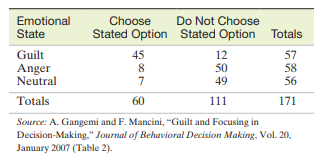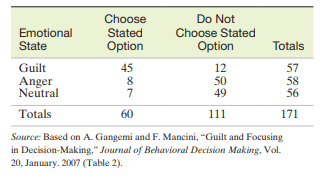Guilt in decision making. The effect of guilt emotion on how a decision maker focuses on a problem was investigated in the January 2007 issue of the Journal of Behavioral Decision Making (see Exercise 3.48, p. 183). A total of 171 volunteer students participated in the experiment, where each was randomly assigned to one of three emotional states (guilt, anger, or neutral) through a reading/writing task. Immediately after the task, students were presented with a decision problem where the stated option had predominantly negative features (e.g., spending money on repairing a very old car). The results (number responding in each category) are summarized in the accompanying table. Is there sufficient evidence (at ![]() Â = .10) to claim that the option choice depended on emotional state? Use the data saved to answer the question.
 = .10) to claim that the option choice depended on emotional state? Use the data saved to answer the question.

Exercise 3.48
Guilt in decision making. The effect of guilt emotion on how a decision maker focuses on a problem was investigated in the Jan. 2007 issue of the Journal of Behavioral Decision Making (see Exercise 1.32, p. 52). A total of 171 volunteer students participated in the experiment, where each was randomly assigned to one of three emotional states (guilt, anger, or neutral) through a reading/writing task. Immediately after the task, students were presented with a decision problem where the stated option had predominantly negative features (e.g., spending money on repairing a very old car). The results (number responding in each category) are summarized in the accompanying table. Suppose one of the 171 participants is selected at random.

a. Find the probability that the respondent is assigned to the guilty state.
b. Find the probability that the respondent chooses the stated option (repair the car).
c. Find the probability that the respondent is assigned to the guilty state and chooses the stated option.
 d. Find the probability that the respondent is assigned to the guilty state or chooses the stated option.
Exercise 1.32
Guilt in decision making. The effect of guilt emotion on how a decision maker focuses on the problem was investigated in the Journal of Behavioral Decision Making (January 2007). A total of 171 volunteer students participated in the experiment, where each was randomly assigned to one of three emotional states (guilt, anger, or neutral) through a reading/writing task. Immediately after the task, the students were presented with a decision problem (e.g., whether or not to spend money on repairing a very old car). The researchers found that a higher proportion of students in the guilty-state group chose to repair the car than those in the neutral-state and anger-state groups.
a. Identify the population, sample, and variables measured for this study.
b. Identify the data-collection method used.
c. What inference was made by the researcher?
d. In later chapters you will learn that the reliability of an inference is related to the size of the sample used. In addition to sample size, what factors might affect the reliability of the inference drawn in this study?
"Looking for a Similar Assignment? Get Expert Help at an Amazing Discount!"


